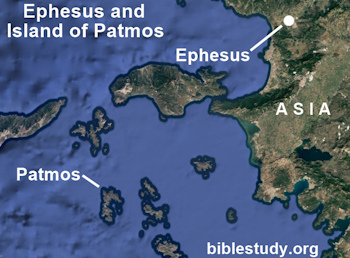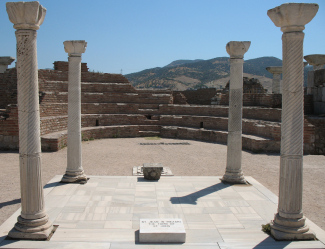Part 1 of this series discusses John life from his birth to just before Jesus' last Passover in 30 A.D. Part 2 of this series covers his life from the last Passover to Jesus' ascension into heaven.
Part 1 of Timeline - Part 2 of Timeline
May 18 to 28, 30 A.D.
Waiting for Power
John, after Jesus' ascension on May 18, is named as one of the many disciples who waited in Jerusalem for the promise of receiving power on the Day of Pentecost (Acts 1:13).
[What Is the Meaning of Pentecost?]
30 to 31 A.D.
A Miraculous Public Healing
A man, born lame, is healed by Peter (with John in tow) at Jerusalem's temple (Acts 3). Peter then uses the opportunity to preach the gospel and convert about 5,000 people (Acts 4:4).
Jewish religious leaders, primarily the Sadducees, arrest the pair because they preached the resurrection of the dead through Jesus. The pair, after Peter explains by what power the man was made whole, are ultimately released without being punished (Acts 4).
32 A.D.
The Gospel Reaches Samaria
The apostles, when they hear that the gospel is being preached in Samaria, send Peter and John to investigate. Upon their arrival they lay hands on those who had been baptized so that they could receive God's spirit (Acts 8:14 - 17). The pair stay in Samaria for a short time before returning to Jerusalem.
42 A.D.
John's Gospel
Evidence suggests the main body of John's gospel was written in 42 A.D. The prologue and epilogue, however, and the finalizing of the text likely took place at or shortly after 96 A.D. Both the gospel of John and Mark, written the same year, are tied for the third oldest New Testament books. Only the gospel of Matthew (35 A.D.) and the book of James (40 to 41) are older.
[When Was the New Testament Written?]
According to the Holy Bible, a Faithful Version (Second Edition, pg. 52), John left Jerusalem in 42 A.D. after writing most of his gospel. He left the city, like many of the other apostles, to spread the gospel far and wide.
Spring 44 A.D.
Death of John's Brother
Herod Agrippa I, the Roman puppet king over Judea, decides to enhance his favor with the Jews by harassing the early New Testament church. He first arrests some Christians including James, the older brother of John. He then executes James, making him the first of the twelve apostles to die for his faith.
Now about that time, Herod the king stretched forth his hands to persecute some of those of the church;
And he killed James, the brother of John, with the sword. And when he saw that it pleased the Jews, he proceeded to take Peter also. (Now those were the days of unleavened bread.) (Acts 12:1 - 3, HBFV throughout).
[Murder in the New Testament!]
Although Herod arrested Peter, in possible preparation to kill him, the apostle is miraculously freed by an angel (Acts 12:4 - 11)!
Summer to Late Fall 49 A.D.
The Jerusalem Conference
John returns to Jerusalem at an unknown time before the Jerusalem Conference. This conference of church elders and brethren is held to settle the question of whether Gentile converts needed to be circumcised or not. Attending this gathering is Paul, Barnabas and others who traveled from Syrian Antioch to help resolve this divisive dispute.
When the Apostle Paul arrives in Jerusalem he meets with Peter (Cephas), James (Jesus' half-brother) and John.
And after recognizing the grace that was given to me, James and Cephas and John - those reputed to be pillars - gave to me and Barnabas the right hands of fellowship, affirming that we should go to the Gentiles, and they to the circumcision (Galatians 2:9, HBFV throughout).
John likely, after the conference, leaves again to travel and spread the gospel.
63 to 64 A.D.
Writing Epistles
The books of 1, 2 and 3John are written by John likely from Ephesus.
The theme of 1John is a Christian's fellowship with God the Father and Jesus Christ. 2John is a letter that commends the behavior of a particular Christian woman but also warns of heresies and false teachers spreading with the church. 3John is a letter to a man named Gaius warning him of a church leader named Diotrephes whose personal ambitions were adversely affecting a local fellowship.
c. 67 to 68 A.D.
Fleeing the Wrath of Rome
According to church historian Eusebius (c. 260 - 265 to 339 A.D.), the Christians in Jerusalem are warned by God of the city's impending destruction by the Romans (Eusebius, Church History 3, 5, 3). The Apostle John, along with other Jewish Christians, flee the city for Pella.
[Map of Roman Empire at its Peak!]
Pella is located about 17 miles (27 kilometers) south of the Sea of Galilee on the eastern side of the Jordan River. John, at an unknown time after arriving in Pella, then travels to Asia Minor (Holy Bible, a Faithful Version, Second Edition, Chronology VI).

A fascinating and often overlooked fact about this advance fleeing of God's wrath is that it likely took place within a Sabbatical year! The Sabbatical year ran from Monday, September 28 in 67 A.D. to Thursday, September 15 in 68.
95 to 96 A.D.
Boiled, Exiled and Inspired
Roman Emperor Domitian begins to carry out a wave of persecutions against Christians. Between 95 and 96 A.D., according to tradition, John survives a death sentence only to be banished to the island of Patmos (Revelation 1:9).
"From Ephesus he (Apostle John) was ordered to be sent to Rome, where it is affirmed he was cast into a cauldron of boiling oil. He escaped by miracle, without injury. Domitian afterwards banished him to the Isle of Patmos, where he wrote the Book of Revelation." (Foxe's Book of Martyrs, section 1).
Emperor Domitian dies in September 96 and is succeeded by Emperor Nerva. After this transition the apostle John is released from Patmos and makes his way back to Ephesus.
96 to 99 A.D.
Canonizing the New Testament
John, in Ephesus, finishes a few important tasks before his death. He edits and adds to his gospel, the body of which he completed in 42 A.D. He then, along with other church elders, takes on the great labor of canonizing (finalizing) and arranging the books that we know today as the New Testament.
[Where Were Bible Books Written?]
"Although Paul and Peter had canonized their writings before they died, the official canonization with the final arrangement of the books of the entire New Testament was accomplished by the apostle John in 96 - 99 AD.
"As one of the last living apostles and the last living eyewitness of Christ’s transfiguration, John was uniquely qualified and chosen by Jesus to canonize the entire New Testament in its final form." (Holy Bible, a Faithful Version, Second Edition, pg. 71).
John's efforts complete God's written testimony to mankind.
"With this final warning (see Revelation 22:18 - 19), the apostle John - of the lineage of Aaron, uniquely chosen and qualified by God the Father and Jesus Christ - finished the canonization of the New Testament, the most magnificent book in the world.
"Once this task was finished, the New Testament was added to the Old Testament. Thus, the full revelation of God to mankind was completed by the disciple whom Jesus especially loved - the apostle John." (ibid., pg. 73).

c. 100 A.D.
Death of the Last Apostle
The Apostle John, the last of the twelve apostles still alive, dies of natural causes around 100 A.D. He is believed to have died in Ephesus.
One of the legacies John left behind were Christians willing to stay true to what the Bible teaches. One of these was named Polycarp (69 to 155 A.D.), who both Irenaeus (Adversus Haereses III.3) and Tertullian (De praescriptione hereticorum 32.2) attest was a disciple of John.